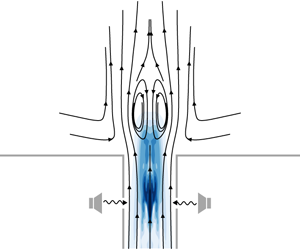Crossref Citations
This article has been cited by the following publications. This list is generated based on data provided by
Crossref.
Lückoff, Finn
Sieber, Moritz
Paschereit, Christian Oliver
and
Oberleithner, Kilian
2020.
Impact of the Precessing Vortex Core on NOx Emissions in Premixed Swirl-Stabilized Flames—An Experimental Study.
Journal of Engineering for Gas Turbines and Power,
Vol. 142,
Issue. 11,
Sieber, Moritz
Paschereit, C. Oliver
and
Oberleithner, Kilian
2021.
Stochastic modelling of a noise-driven global instability in a turbulent swirling jet.
Journal of Fluid Mechanics,
Vol. 916,
Issue. ,
Sieber, Moritz
Paschereit, Cristian Oliver
and
Oberleithner, Kilian
2021.
Impact of density stratification on the global mode in a swirling jet: Stochastic modelling and Lagrangian coherent structures.
International Journal of Heat and Fluid Flow,
Vol. 90,
Issue. ,
p.
108820.
Lückoff, Finn
Kaiser, Thomas Ludwig
Paschereit, Christian Oliver
and
Oberleithner, Kilian
2021.
Mean field coupling mechanisms explaining the impact of the precessing vortex core on the flame transfer function.
Combustion and Flame,
Vol. 223,
Issue. ,
p.
254.
Litvinov, Ivan
Sharaborin, Dmitriy
Gorelikov, Evgeny
Dulin, Vladimir
Shtork, Sergey
Alekseenko, Sergey
and
Oberleithner, Kilian
2022.
Modal Decomposition of the Precessing Vortex Core in a Hydro Turbine Model.
Applied Sciences,
Vol. 12,
Issue. 10,
p.
5127.
Zhang, Pan
Chen, Guanghui
Wang, Weiwen
Zhang, Guodong
and
Wang, Huaming
2022.
Analysis of the nutation and precession of the vortex core and the influence of operating parameters in a cyclone separator.
Chinese Journal of Chemical Engineering,
Vol. 46,
Issue. ,
p.
1.
O’Connor, Jacqueline
2023.
Understanding the role of flow dynamics in thermoacoustic combustion instability.
Proceedings of the Combustion Institute,
Vol. 39,
Issue. 4,
p.
4583.
Kaiser, Thomas L.
Demange, Simon
Müller, Jens S.
Knechtel, Sophie
and
Oberleithner, Kilian
2023.
FELiCS: A Versatile Linearized Solver Addressing Dynamics in Multi-Physics Flows.
Shtork, Sergey
Suslov, Daniil
Skripkin, Sergey
Litvinov, Ivan
and
Gorelikov, Evgeny
2023.
An Overview of Active Control Techniques for Vortex Rope Mitigation in Hydraulic Turbines.
Energies,
Vol. 16,
Issue. 13,
p.
5131.
Farzamnik, E.
Ianiro, A.
Discetti, S.
Deng, N.
Oberleithner, K.
Noack, B.R.
and
Guerrero, V.
2023.
From snapshots to manifolds – a tale of shear flows.
Journal of Fluid Mechanics,
Vol. 955,
Issue. ,
Reumschüssel, Johann Moritz
Li, Yiqing
zur Nedden, Philipp Maximilian
Wang, Tianyu
Noack, Bernd R.
and
Paschereit, Christian Oliver
2024.
Experimental jet control with Bayesian optimization and persistent data topology.
Physics of Fluids,
Vol. 36,
Issue. 9,
Kim, Jong-Chan
Yoo, Euisung
and
Sung, Hong-Gye
2024.
Influence of liquid-fuel swirl injection pressure on the flow dynamics characteristics in a lean direct injection gas turbine combustor using Eulerian-Lagrangian large eddy simulations.
Journal of Mechanical Science and Technology,
Vol. 38,
Issue. 2,
p.
691.
Li, Xiao-Bai
Demange, Simon
Chen, Guang
Wang, Jia-Bin
Liang, Xi-Feng
Schmidt, Oliver T.
and
Oberleithner, Kilian
2024.
Linear stability and spectral modal decomposition of three-dimensional turbulent wake flow of a generic high-speed train.
Journal of Fluid Mechanics,
Vol. 1000,
Issue. ,
Moczarski, Lukas
Treleaven, Nicholas C. W.
Oberleithner, Kilian
Schmidt, Simon
Fischer, André
and
Ludwig Kaiser, Thomas
2024.
Interacting Linear Modes in the Turbulent Flow of an Industrial Swirled Combustor.
AIAA Journal,
Vol. 62,
Issue. 3,
p.
979.
Zhou, Yuyang
and
Rinoshika, Akira
2024.
Experimental study of flow dynamics in a dual-stage annular swirling jet.
Physics of Fluids,
Vol. 36,
Issue. 12,
Frank-Sapir, Ofek
and
Gluzman, Igal
2025.
Input-Output Approach to Study Energy Pathways in Transitional Boundary Layer, Focusing on Nonlinear Response to Actuation.
Colanera, Antonio
Reumschüssel, Johann Moritz
Beuth, Jan Paul
Chiatto, Matteo
de Luca, Luigi
and
Oberleithner, Kilian
2025.
Extended cluster-based network modeling for coherent structures in turbulent flows.
Theoretical and Computational Fluid Dynamics,
Vol. 39,
Issue. 1,
